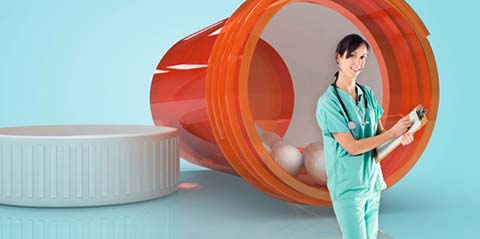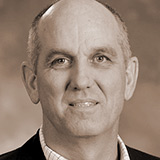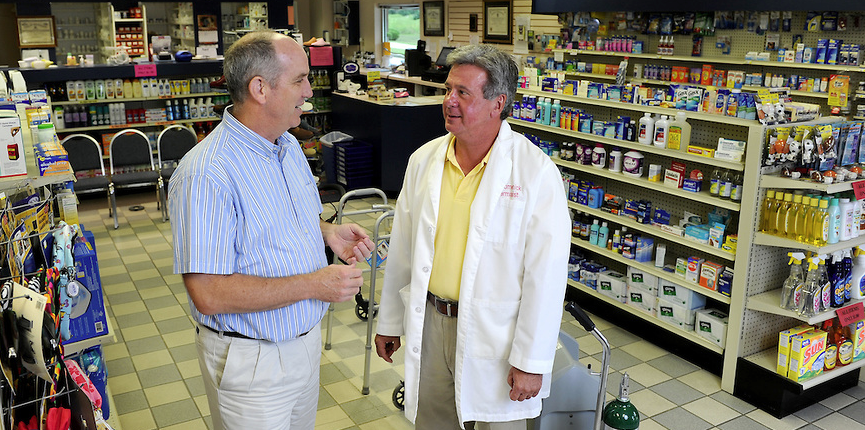


Ben Banahan
In the United States, where as many as half of all prescription medicines aren’t taken as prescribed, lack of prescription adherence is a serious problem that escalates health care costs and compromises patient health.
That’s why streamlining pharmacy practice is a win-win solution for pharmacists and their patients. RxSync®, a business model developed at the UM Center for Pharmaceutical Marketing and Management, helps pharmacists restructure their practices with the goal of greater efficiency while also helping patients adhere to prescription instructions.
The model was developed after Ben Banahan, the center’s director and research professor in the Research Institute of Pharmaceutical Sciences, met a pharmacist in Winona who had developed a creative solution for serving his rural community.
The pharmacist, Stanley Devine, realized many patients in the rural area needed home delivery but lived outside the limits serviced by the area’s pharmacies. The decision to serve their needs by providing extended home delivery required Devine and his company, PharmNet, to rigorously schedule delivery routes. By working one-on-one with patients and synchronizing prescriptions whenever possible, PharmNet ensured patients received medications on time. The outcome was not only greater efficiency but also better adherence, thanks to improved communication between pharmacist and patient.

Erin Holmes
Banahan helped Devine put together a business plan and partnered with him to package, license and market the RxSync Service℠, starting with other community pharmacies in Mississippi. A grant from Cardinal Health allowed them to pilot RxSync in five pharmacies and evaluate the results. Banahan also enlisted the support of Erin Holmes, assistant professor of pharmacy administration and research assistant professor in the Research Institute of Pharmaceutical Sciences.
Community pharmacists who are part of the RxSync Pharmacy Network call patients each month to ensure that medication is being taken as prescribed and to review any side-effects. That’s key, because uninformed patients may otherwise misinterpret side-effects as signs that a medication isn’t working as it should, or they may attempt to modify their dosage, combine medications inappropriately or cease taking a drug altogether. With RxSync, pharmacists can reassure patients and encourage them to make good decisions. If needed, pharmacists can even call a patient’s doctor to review dosages or refills, or make professional recommendations regarding treatment adjustments.
—Ben Banahan
“The pharmacy becomes not a place where you go to pick up prescriptions, but rather a provider of health care services,” Banahan said. “With RxSync, pharmacists perform all their dispensing functions, but much more efficiently and with much better work flow, so they now have more time for patient care.”
Because of its patient-centered approach, RxSync aligns with what many people envision may be the future of American health care.
“A big part of the issue is that pharmacy has been a reactive practice,” Banahan said. “The profession is transforming into an active, patient-centered system instead. That’s a lot of what RxSync helps the pharmacist do.”
The University of Mississippi owns the trademark to the RxSync and licenses the practice model to pharmacies. Community pharmacists participating in the RxSync practice model benefit from communicating with one another about what has worked well within their pharmacies. They also benefit from being able to use the RxSync name in their marketing and to participate in research projects that document the benefits of the service to the pharmacy, patients and payers.
Recent changes to the CMS Medicare Advantage Program added quality indicators to encourage beneficiaries to use better, more efficient, higher quality Medicare plans. The program assigns star ratings to different plans. In 2012, pharmacy adherence measures were added to the star system, which means systems like RxSync may help plans receive higher star ratings. Medicare’s emphasis on adherence is based on the reasoning that adherence saves money and lives.
“If adherence goes up, emergency room and hospital visits go down,” Banahan said. “It saves the entire health care system money if you do it well. If you improve adherence, your prescription costs go up, but you can usually see a bigger drop on the medical side that more than pays for it.”
The relationship between medication use and health outcomes is at the forefront of other center projects as well. Two years ago, the University of Mississippi became the official Drug Utilization Review Board, or MS-DUR, for the state. In this role, UM serves as a consultant for Mississippi Division of Medicaid, studying pharmacy and medical claims data to encourage evidence-based, appropriate use of medications and medical services in the Mississippi Medicaid population. For example, recent studies examined the use of anti-psychotic drugs in mental health care for Mississippi’s foster children and costs associated with overuse of emergency room services.
The MS-DUR research has run the gamut from small to large projects. MS-DUR allows graduate students to gain practical experience in programming analysis and also gives the Center for Pharmaceutical Marketing and Management access to broader data for its research. In turn, the Mississippi Division of Medicaid receives quality service while supporting a fellow state institution.
“It’s been a very mutually beneficial relationship,” Banahan said. “We look forward to expanding our project to work with additional groups within the Division of Medicaid and hope to eventually do similar work with the State and School Employees’ Health Insurance Plan, the other major publically funded health plan in Mississippi.”





